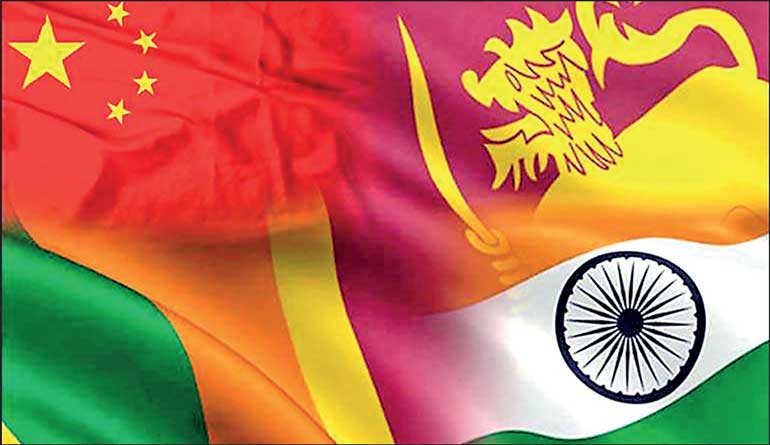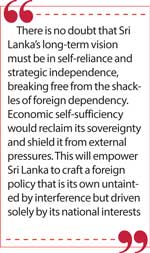Monday Apr 07, 2025
Monday Apr 07, 2025
Friday, 14 February 2025 00:26 - - {{hitsCtrl.values.hits}}

 Introduction
Introduction
a) The new NPP Government finds itself navigating a delicate diplomatic tightrope between two Asian powerhouses—global powerhouse China, pouring billions into Sri Lankan infrastructure, and resurgent neighbouring economic power, India, deeply concerned about security implications of Sri Lanka aligning too closely with its rival, China.
b) The new administration must maintain perfect balance: lean too far toward Beijing’s Belt and Road ambitions and risk alarming New Delhi; pivot too strongly toward Indian interests, and potentially compromise crucial Chinese investments.
c) Foreign visits. During his recent visit to India, President AKD reaffirmed Sri Lanka’s commitment to safeguard India’s strategic interests, assuring that Sri Lankan territory would not be used for activities inimical to India’s security. During his subsequent visit to China, he secured substantial economic assistance, reinforcing greater Chinese involvement in Sri Lanka. India could perceive that as a shift in Sri Lanka’s alignment toward greater Chinese influence.
d) JVP/NPP outlook. India and China are well aware that the JVP is the driving force behind the NPP Government, and that its founder, Rohana Wijeweera, harboured an ideological leaning toward China. It is said that Rohana Wijeweera was barred from resuming his medical degree at Patrice Lumumba University in the USSR (Russia) due to his criticism of the Russian model of socialism in favour of the Chinese version.
Aim
The aim of this paper is to unravel local perceptions of each country, examine the resultant intricate challenges shaping bilateral relationships, and how best to transform them into strategic opportunities through astute political judgement and economic pragmatism.
Analyses
1. Global trends
a) BRICS. China and India are founder members of BRICS, the latest global economic block and are locked in a fierce rivalry for regional supremacy.
b) Sino-Indian disputes. The Indo-China War of 1962 and the dispute over the autonomous region of Tibet have contributed to these tensions, exacerbated further by the deadly clash in Galwan Valley in 2020 and the Chinese initiative to build a dam on the Yarlung Tsangpo River (the Brahmaputra in India).
c) Sine-Indian reconciliation. However, meetings between Narendra Modi and Xi Jinping last October followed by a review by senior officials of the two countries on the resumption of the Kailash Mansarovar Yatra this summer and discussions on cooperating on trans-border rivers have eased tensions.
d) Manipulation. External powers strategically exploit these regional tensions to impede China’s rapid economic ascendancy and its Belt and Road Initiative (BRI). India’s membership in QUAD (Quadrilateral Security Dialogue) appears to be a direct effort in pursuit of that.
e) India’s neighbours. While India boasts a remarkable long history of tolerance and inclusivity, its recent relationships with neighbouring countries have faced notable strain. The deep-seated enmity with Pakistan shows little sign of resolution. The exile of Sheikh Hasina and her subsequent refuge and protection by India have soured bilateral ties with Bangladesh.
2. Factors affecting Indo-Sri Lanka relationship and interactions
2.1 Advent of Buddhism and early assimilations

a) Buddhism. The greatest relationship between the two countries is the advent of Buddhism to Sri Lanka from India. That has had a profound impact on shared cultural values.b) Vijaya. The Mahavamsa narrative of Vijaya’s arrival from India, marking the beginning of the Sinhala race, holds significant cultural importance, although the authenticity and historical accuracy of the story need scholarly debate.
c) Invasions. The recurrent and sporadic invasions of Sri Lanka by South Indian powers for nearly a millennium forced Sinhalese Kingdoms to repeatedly retreat, abandon and withdraw to find realms elsewhere. It is ingrained in the mindset of Sinhala inhabitants creating a suspicious and anti-Indian sentiment.
d) Mahawamsa and Dutugemunu. This is intensified by the core story in the Mahavamsa of the warrior King Dutugemunu defeating the Tamil King Elara. Mahavamsa is considered historically accurate though embellished with exaggerations; 11 out of 37 chapters are about the warrior king Dutugemunu whilst only 6 chapters cover the reigns of 52 other kings. Yet, the Dutugemunu narrative is entrenched in the minds of the majority Sinhalese enchanted by its heroic allure and vivid portrayal.
e) Early Indian migrations. Sri Lanka and India are separated only by the narrow strip of Palk Bay, making it highly probable that many from South Indian states have migrated and settled in Sri Lanka since antiquity. They became to be known as Sri Lankan Tamils. Some scholars believe that the earliest Buddhists in Sri Lanka were Tamils who later converted to other religions. Manimekalai and Kuṇṭalakēci, are epics in Tamil Buddhist culture. That could be the reason for ancient Buddhist religious structures in Northern Sri Lanka.
2.2 The Kandyan Kingdom and Nayakkar Dynasty
A significant Indian interaction was the last dynasty to rule Sri Lanka, the Nayakkars of Madurai from 1739 until the British conquest in 1815.
2.3 Malayaga Tamil community
The colonial British introduced Indian labourers from Tamil Nadu (Chennai). They identify themselves as Malayaga and have been confined to squalid and miserable living conditions of tea estates until the recent expectation of emancipation by the promises of the new NPP Government in Sri Lanka.
2. 4 Illegal Indian immigrants (Kallatoni)
Since Sri Lanka had far better living conditions, many poor South Indians illegally migrated to Sri Lanka in the 1950s and 1960s leading to the formation of Task Force Anti Illicit Immigration (TAFII) of the Sri Lanka Army. Nevertheless, many of those illegals would have sneaked through and integrated into the Sri Lankan society prompting Sri Lanka Navy to designate the operation of Naval assistance for the annual Kachchativu festival as ‘Operation Sneaker’.
2.5 International Maritime Boundary and Kachchativu
a) UNCLOS. The United Nations Convention on the Law of the Sea (UNCLOS) establishes territorial waters as sea areas extending 12 nautical miles from a nation’s coastline. When territorial waters of neighbouring countries overlap, the boundary is set by the median line – an imaginary border drawn equidistant from each nation’s mainland coast.
b) Legal status. Of the many islands between India and Sri Lanka, the desolate Kachchativu island is farthest from Sri Lanka. Yet, like all other islands, it is in Sri Lanka’s territorial waters, by being within the Sri Lanka side of the median line. Kachchativu island has always been Sri Lankan territory and was never ceded to Sri Lanka by India.
c) Kachchativu Agreement. Consequently, India and Sri Lanka signed the Kachchativu agreement in 1974 recognising that Kachchativu belonged to Sri Lanka. That agreement was acclaimed internationally as a model of amicably demarcating country boundaries.
2.6 Poaching by Indian trawlers
For at least the past 50 years swarms of Indian trawlers poach in Sri Lankan waters in the Palk Straits and Palk Bay carrying out bottom trawling for jumbo prawns. Bottom trawling is banned as it destroys spawning grounds. This is another significant matter for anti-Indian sentiments.
2.7 Separatism and protracted conflict in Sri Lanka
An insurgency clamouring for a separate state for the Tamil community of the North of Sri Lanka started in the 1980s. The main separatist movement was classified as a terrorist group and proscribed internationally. Yet, it is well known that India actively supported the terrorist groups and even armed and trained them. That naturally provoked the most intense wrath of the majority of Sri Lankan society. India was perceived as the partner in crime and an equal villain and still looked at with suspicion and disdain.
2.8 Indian military intervention and IPKF
IPKF misadventure. The ill-conceived Indian military intervention in Sri Lanka through what was known as the Indian Peace Keeping Force (IPKF) became a tragic irony. It transformed into a volatile quagmire when the insurgents turned against the IPKF in retaliation to their systematic subjugation and abuse of the innocent local Sri Lankan Tamil community. This disastrous intervention precipitated a cycle of vengeance leading to even the assassination of Indian Prime Minister Rajiv Gandhi. Naturally, the majority of Sri Lankans vehemently opposed and despised the Indian intervention.
2.9 Alienation of Tamil community in Sri Lanka
a) Succour from India. Both Sri Lankan Tamils and the Malayaga community share a deep cultural connection with India, often placing greater trust and faith in the Indian central and southern state governments. Rather than seeking solutions from within Sri Lanka, they tend to look to India for support and resolution of their longstanding challenges.
b) Failure of Sri Lanka. That is a grave indictment of the majority population and successive Sri Lankan Governments for failing to make a genuine effort to integrate them into the society. Marginalisation has left them feeling alienated and disconnected, creating a potential vulnerability. They could well become a fifth column for India, as was evident during the separatist insurgency when ethnic ties played a significant role in allegiances.
2.10 Afanasy Nikitin Cobalt seamount
a) Location. Named after a Russian explorer, the Afanasy Nikitin Cobalt seamount lies about 1,000 km south of Sri Lanka. It is a rich deposit of cobalt, in high demand for rapidly growing industries, particularly for clean energy, advanced technologies, electric vehicles (EVs) and aerospace and defence applications. The global cobalt supply is limited and is classified as a critical mineral by many countries, increasing efforts to secure stable supplies.
b)Value. It is speculated that the area may hold deposits worth up to $ 80 billion.
Rights for development. Sri Lanka, being closest to the seamount, has obtained rights for it in 2009 from the International Seabed Authority (ISBA) claiming it as part of its extended continental shelf as provided in UNCLOS.
c) India’s interest. India, in pursuit of their technological developments and concerned about Chinese control of cobalt resources, has recently submitted a bid to explore the seamount. The ISBA is in a quandary since Sri Lanka has already obtained the rights. The Indian newspaper ‘The Hindu’ recently reported that India’s sudden interest is a gambit motivated by reports of Chinese vessels undertaking reconnaissance in the area.
2.11Indian economic assistance and diplomatic support
India has consistently extended economic assistance to Sri Lanka in various forms during times of need, while also offering crucial diplomatic support in moments of crisis.
3. Factors affecting Sino-Sri Lanka relationship and interactions
3.1 Buddhism – Visit of Fa Hien
Seeking to deepen his understanding of Buddhism, the Chinese monk Fa Hien visited Sri Lanka in the early 5th century to study Buddhism. His deep scholarly studies of Buddhism in Sri Lanka may have influenced the shaping of Chinese Buddhism.
3.2 China’s naval superiority and capture of Alakeshvara
a) Capture of King Veera Alakeshvara of Raigama. Due to the vast geographical distance between the two nations, Chinese military actions in Sri Lanka were limited to the capture of King Veera Alakeshvara of Raigama and his family by the Chinese Admiral Zheng He around 1411 during his third voyage on behalf of the Ming dynasty.
b) The Galle trilingual inscription stone tablet. Written in Chinese, Tamil, and Persian, it is attributed to Admiral Zheng He during his expeditions. That was long before Bartholomew Dias rounded the Cape of Good Hope in 1488 paving Vasco de Gama to Calicut in 1498 and Lorenzo de Almeida to Galle in 1505.
3.3 Rubber-Rice Pact
Originally in the 1950s and thereafter in the 1970s, the Rubber-Rice Pact was a bilateral trade agreement that created closer economic and diplomatic ties between the two countries.
3.4 Military assistance in the aftermath of the 1971 insurrection
When the Sri Lankan military was unprepared for the youth uprising and insurrection in 1971, China swiftly came to the assistance by upgrading military hardware.
3.5 BMICH
Among many other economic assistance by the Chinese, the most prominent is the BMICH built in the mid-1970s.
3.6 Economic assistance and diplomatic support
China, like India, has consistently extended economic assistance to Sri Lanka in various forms during times of need, while also offering crucial diplomatic support in moments of crisis.
4. Balance of power
4.1 Epicentre of global power competition in the Indian Ocean
a) Transhipment centre. Sri Lanka’s central location in the Indian Ocean has made it a major transhipment centre becoming a global maritime hub through which nearly two-thirds of global energy shipments and half of container traffic pass.
b) Strategic value. Centrally located between critical maritime choke points of Malacca Straits, Bab-el-Mandeb and Hormuz Straits, the location has immense strategic value for both military and commercial purposes.
c) Trincomalee. This twin asset of a naturally sheltered harbour and an extensive oil tank farm positions Trincomalee as a potential game-changer in Indian Ocean maritime commerce and energy security.
d) Cobalt, graphite, quartz and ilmenite. In addition to Afanasy Nikitin Cobalt, Sri Lanka has large deposits of some of the most valued minerals, the purest form of graphite in the world (Ceylon vein graphite), quartz and Ilmenite, attracting interest from international players including both China and India.
4.2 The Sethusamudram Shipping Canal Project
This Indian plan is to create a navigable waterway by dredging a canal through Adam’s Bridge (Ram Setu), for ships to travel between India’s East and West Coasts without circumnavigating Sri Lanka. It will not have any significant impact on international shipping that typically transit south of Sri Lanka. India faces considerable challenges in undertaking the project, including high costs, environmental and ecological concerns, shallow waters, and strong opposition from those who view dredging Ram Setu a sacrilegious exercise as it is believed to have been built by Lord Rama according to the epic, the Ramayana.
4.3 The proposed bridge connecting India and Sri Lanka
This faces the same problems and it is difficult to understand any justifiable advantage or benefit to Sri Lanka as sea transport between the two countries provides far more scope, connectivity, flexibility and convenience.
Conclusion
a) Independence. There is no doubt that Sri Lanka’s long-term vision must be in self-reliance and strategic independence, breaking free from the shackles of foreign dependency. Economic self-sufficiency would reclaim its sovereignty and shield it from external pressures. This will empower Sri Lanka to craft a foreign policy that is its own untainted by interference but driven solely by its national interests.
b) Pragmatism. Since China is not a neighbour and is far away, any reaction from China will be inherently limited to economic and diplomatic repercussions. This allows Sri Lanka to maintain a pragmatic relationship with China focused on economic and political engagement.
c) Chinese influence. While Sri Lanka maintains productive economic ties with China and learns from its development model that has lifted millions out of poverty, China’s influence remains primarily commercial. China has limited social or cultural connections within Sri Lankan society, constraining its ability to significantly shape domestic dynamics.
d) Chinese naval visits. Even under pressure from India, Sri Lanka need not be overly concerned about any visit of Chinese Naval ships, but instead maintain a consistent and equitable protocol for naval vessels of all countries.
e) Historical lesson. A profound historical lesson lies in Sri Lanka’s role during the Bangladesh Liberation War of 1971 when maintaining a stance of neutrality, Sri Lanka granted landing rights to military aircraft from Pakistan, a belligerent party, on their way from West Pakistan to East Pakistan (now Bangladesh), when the belligerents were India and Pakistan.
f) Indian influence. Due to proximity and historical precedents, India has a greater capacity to create political instability in Sri Lanka through subversion. India fomenting discord is possible mainly due to a segment of the Sri Lankan population aligning themselves closer to India to resolve their identity challenges, in effect, becoming a fifth column. That affinity to India has been caused by the failure of successive Sri Lankan governments and the majority Sinhala population to integrate them into society by accepting and accommodating them as Sri Lankans.
g) National security only through national harmony. Sri Lanka can be truly independent without concerns of Indian influence and achieve peace and prosperity only when all communities identify as Sri Lankans whilst maintaining cultural diversities. For that, they should be confident that whatever concerns, real or perceived, would be redressed internally without finding solace from India. Only then would the minority communities have faith and loyalty in a government they can trust without resorting to external succour. That is possible only by inclusivity, not exclusivity, as explained in my recently published article titled; “National security only through national harmony” (see link at Footnote).
h) Success. Success in balancing the two Asian powerhouses requires diplomatic finesse: maintaining transparency with both powers and preventing either nation from gaining an overwhelming influence over Sri Lanka’s foreign policy. For the first time in history, all the communities in Sri Lanka have given NPP the mandate to do it.
Footnotes:
Link to the previous article (paragraph (g) of Conclusion);
https://www.ft.lk/columns/National-security-only-through-national-harmony/4-770154
(The writer may be contacted at [email protected].)